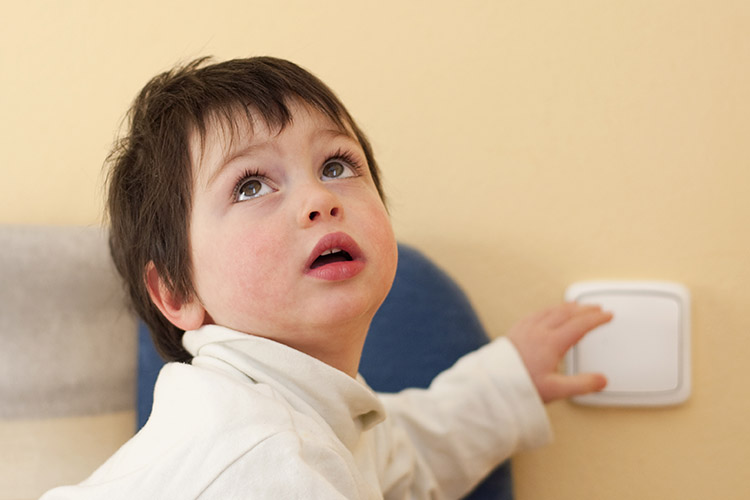How Do I Know if My Child Has Autism?

Autism Spectrum Disorder (ASD) is a disorder which is based on a collection of characteristics. Due to the nature of a “spectrum” disorder, there is varying degrees of severity and presentation of the characteristics associated with ASD. No two children with ASD are alike. Only a medical doctor or clinical psychologist can actually diagnose ASD. These professionals look for a number of diagnostic criteria to warrant the diagnosis of ASD. Many of the diagnostic criteria for ASD are related to difficulties or impairments in social skills and communication. Therefore, Speech-Language Pathologists (SLPs) have a great deal of experience in treating individuals with ASD; however, SLPs are not the professionals who diagnose it.
What are some of the signs of autism?
Autism Spectrum Disorder is an extremely complex diagnosis affecting multiple areas of development, particularly communication and social behaviour. Even highly trained professionals who have extensive experience with evaluating autism should always consult multiple sources (e.g., parents, teachers, therapists), who are associated within that child’s circle of care, to obtain a full picture of the child’s functioning in a variety of situations before making a diagnosis.
Typical signs of autism
The following is a list of “typical” signs seen in infants/children with a diagnosis of ASD; however, these symptoms must not be viewed individually but rather as a group. In other words, some children who are not on the autism spectrum may exhibit some of these symptoms, and some children who are on the autism spectrum may not exhibit all of these symptoms.
Possible signs of autism in infants
6 months old
- infant is not smiling socially (i.e., does not smile when interacting with people, does not smile when smiled at)
- limited eye contact
9 months old
- limited vocal use, absence of babbling and social smiles
12 months
- limited nonverbal communication (e.g., pointing, waving, reaching to be held)
- limited vocal use (no words or babbling)
- crying is erratic and not communicative in nature. For example, most normally developing infants will cry to communicate discomfort (hunger, wet/soiled diaper, cold, fatigue) or protest; however, the cries of a child with ASD are not easily interpreted by the caregiver and may be random and/or unpredictable
- does not respond to his/her name
- does not follow simple directions (e.g., “Wave good-bye”, or “Don’t touch that”)
18 months
- no meaningful words
- absence of symbolic play (e.g., does not pick up toy food and pretend to eat it, or “play house” with household objects)
24 months
- verbal output is either absent or not meaningful (e.g., may be limited to reciting alphabet, numbers or colours/shapes)
- not combining meaningful 2 word phrases (e.g., children with ASD may be able to verbally recite long songs, rhymes or frequently heard commercials, but be unable to spontaneously generate single words which are socially meaningful)
- requesting is not verbal (e.g., may pull the caregiver by the hand to the desired object instead of verbally requesting it)
- loss of previously acquired verbal output (e.g., may have used words or babbled sounds in the past which become “lost” and not heard again)
Possible signs of autism (any age)
- Lack of eye contact
- Prefers to play alone
- Prefers the company of adults over other children
- Delayed speech and language milestones
- Repeats frequently heard phrases over and over (echolalia)
- Rigidity to routine and is easily upset if routine changes
- Interests may be unusual and/or limited
- Performs repetitive behaviours to seek stimulation (e.g., hand flapping, rocking, spinning)
- Strong reaction to stimuli such as: loud sounds, bright lights, colours
- Limited tolerance for varied tastes, food textures or smells
How is Autism Treated?
There are a number of health care professionals who are involved in the treatment of autism including (but not limited to): Speech-Language Pathologists (SLP), Occupational Therapists (OT), and Applied Behaviour Analysis (ABA) therapists.
If your child has received a diagnosis of ASD, it is highly likely that he/she is demonstrating delays in the areas of speech and language development and social skills. A Speech-Language Pathologist will do a full evaluation of your child’s total communication profile: speech sound acquisition, expressive language (words in vocabulary, or nonverbal gestures used to express), receptive language (words and directions your child can understand), and social pragmatics (social interaction skills such as eye contact, attention to a task, play skills, communication intent). The Speech-Language Pathologist will then create a treatment plan consisting of goals that will improve your child’s overall communication abilities. Therapy will work in stages. Once your child achieves a goal by demonstrating that new communication skill in their everyday life, a new goal will be developed. Therapy continues in this way so your child keeps progressing.
ABA therapists use principles of learning and motivation to improve the child’s functional behaviours for home life, readiness to enter school, or other programs. ABA therapy will focus on reducing undesirable behaviours and increasing functional and socially appropriate behaviours.
Speech-Language Pathologists and ABA therapists often work together in goal setting and therapy targets in order to optimize a child’s behaviour and communication potential.

Myths about autism treatment
1. We should wait to see if our child is diagnosed with Autism before starting speech therapy.
Regardless of whether your child meets the criteria for a diagnosis of ASD, a Speech-Language Pathologist can start to improve your child’s speech and language skills in therapy. During our first assessment session, we will obtain an overview of your child’s communication skills and then create a treatment plan to target the most functional communication skills first. As your child progresses in therapy we adjust his/her goals by moving up a hierarchy of communication skills.
2. We should get applied behaviour analysis (ABA) therapy before speech therapy.
There is much overlap in the techniques and principles used in speech therapy and behaviour therapy. ABA therapy can benefit children with ASD, but it should not be seen as a replacement therapy for speech therapy. The very heart of autism spectrum disorders is impairments in the areas of communication. Therefore, children who receive speech and language therapy early are able to maximize their communication potential and gains.
3. My family doctor knows my child best, so I should ask him/her to diagnose my child.
It is best to obtain a diagnosis from a professional who has extensive experience with evaluating children for ASD. Developmental paediatricians often have more experience with ASD evaluations in comparison to family physicians, as they specialize in child development versus general health.
4. Obtaining a diagnosis will only hurt my child since he or she will be “labelled”.
In Ontario, there are many resources to assist children who have received a diagnosis of ASD. Many of these resources are publicly funded through your local preschool speech and language initiatives (e.g., Erinoak Kids, Kidsability) and can only be accessed WITH a diagnosis.
5. My doctor gave us the advice to “wait and see” rather than seek any intervention.
Early intervention for children who are delayed in speech and language is the best way to maximize their communication potential! Regardless of whether they meet the criteria for a diagnosis of ASD or not, if their speech and language skills are delayed, receiving intervention to help remediate these delays should happen as early as possible. Furthermore, there are often long wait lists for an evaluation by a developmental paediatrician, so being proactive is a benefit. You can always cancel the evaluation if your child starts to acquire their milestones and no longer shows delays.
One size does not fit all for ASD therapy
No two children with autism are the same. There is not one therapy approach that will fit all children with ASD. The best therapists are those who tailor their therapy approach (and interaction style) to the individual child, capitalizing on that child’s strengths and being responsive to that child’s needs.
